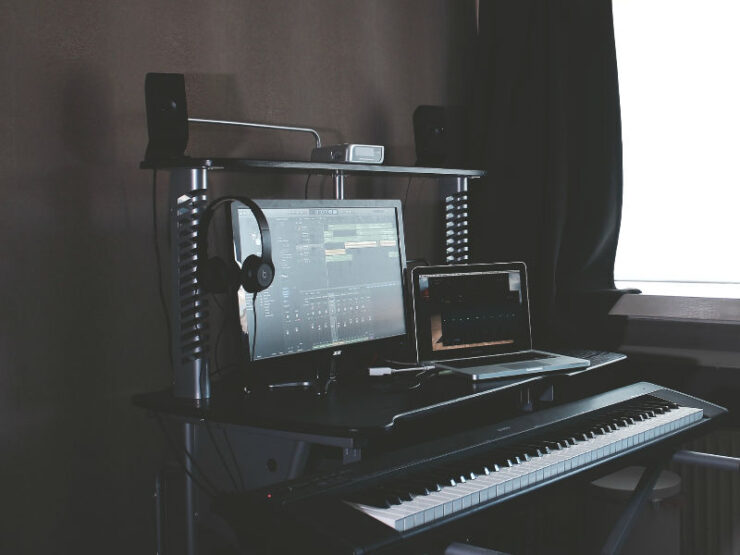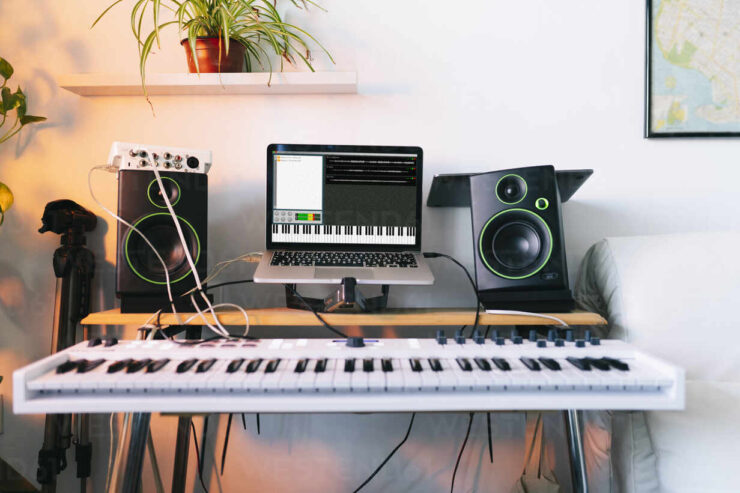Digital pianos are an incredible option in contrast to acoustic pianos. They can be used for any occasion and offer the same level of enjoyment as an acoustic piano.
However, there is one caveat: you need to know how to record them correctly to get the best sound out of your digital piano.
Do you know how to record a digital piano the right way? Have you ever thought about how to do it? You can use a microphone or even plug your guitar into the computer. This article will tell you everything you need to know about recording a digital piano, so be sure not to miss it!
Best Digital Piano Recording Tips

Here’s the way to catch the sound sign from your console/piano. To begin with, you associate your console or piano’s line yield sign to a viable sound interface.
Then, at that point, associate your PC, PC, iPad, cell phone, or iPhone to the interface. At long last, use earphones or studio screens to pay attention to the outcomes. How about we examine how to do it effectively, stepwise.
Step 1: Determine the noise’s origin
Speakers might be remembered for your computerized piano, electronic console, or synthesizer. Nonetheless, to record, you should initially find the line-level yield.
Check your console model’s association in the manual/guidance booklet or on the web. It may feature an ‘Aux Out’ or ‘Line Out’ button. This data will be shown in the ‘Specs’ section.
In addition, it may be labeled [L/L+R][R], (MAIN) L/MONO, R: 1/4′′ TRS Balanced, or (MAIN) L/MONO, R: 1/4′′ TRS Balanced.
Alternatively, as is frequently the case with less priced keyboards, the sole output maybe headphones. That’s OK. If you don’t have any other options, you may record via the headphone.
Step 2: Will you use a computer, laptop, iPhone, or iPad to record?

In this step, you’ll look at how to choose the best audio interface for recording your keyboard. So stated, the audio interface is the unit that converts the sound from your keyboard into a digital signal and sends it to your computer.
However, if you intend to record on an iPad, there’s little use in purchasing an audio interface for a laptop. As a result, choose carefully where you wish to record. Choose an interface that works with many devices for the most excellent versatility.
Step 3: Select an Audio Interface That Is Appropriate For Recording The Signal
To create a good-quality recording of your piano or keyboard, you’ll need an audio interface. There are hundreds to choose from, with a wide range of costs.
So, here are the essential features of your interface: There are two line-level sources of info. You will not have the option to make a nice recording of your console without line-level data sources.
Think about what more you could achieve with the interface when you’re settling on your choice. For instance, is it conceivable to record vocals? Discover that your interface has one mouthpiece input (this will be an XLR input with mic preamp).
Is it reasonable to record guitar? A mouthpiece might be utilized to record acoustic music. Assuming you need to record straightforwardly, check sure the interface incorporates a Hi-Z input that can associate the guitar straightforwardly.
Step 4: Ensure You’ve Got the Right Cables
Examine your keyboard’s OUTPUTs and your interface’s INPUTs. The proper cable is just the one (or many) that connects the two items! For example, you’ll need two 1/4′′ mono TS cables if you have L and R 1/4′′ outputs and L and R 1/4′′ inputs. If the outputs and inputs are both BALANCED (as stated in the instructions), you’ll need two 1/4′′ mono TRS cords.
You’ll require a splitter link of the suitable size if you’re associating your earphone out – or your aux out – to a solitary sound system port. On your interface, this will partition the console’s sound system yield into two mono channels — left and right.
Step 5: Software for recording

At this point, don’t get too worked up over the recording software. First and foremost, make sure you have the proper hardware. The audio interface is likely to come with recording software that you may use to record.
Alternatively, there are a plethora of free or low-cost applications available. For example, audacity may be used on a Mac or Windows laptop or PC. This is entirely free — and it’s fantastic. And it’s simple to use.
You can also use Garageband on a Mac. For iPads and iPhones, there are a plethora of free or low-cost recording applications. Garageband is an excellent application for Apple devices.
Step 6: Pay Attention To The Outcomes
When using an audio interface to record, you’ll typically listen to your recordings via the interface. As a result, you’ll almost likely connect your studio headphones or monitors to the interface’s headphone or audio outputs.
The only exception is if you have a recording interface with no outputs.
If you wish to record the sound of your keyboard on your computer, connect the line out (or headphone out if your keyboard doesn’t have one) from your keyboard to your computer, mac, or iPad. Your financial constraints will determine the method you choose.
Factors To Consider While Recording A Digital Piano
If you are still looking for the best way to capture your performances on a digital piano, there are many ways of doing it. Unfortunately, to verify, a guaranteed method works for every situation (person or equipment), but some actions result in better results than others.
Here are five key factors to consider while recording to ensure that the result will be closer to what you heard in your headphones/monitoring system.

1. Recording technique
The first thing you should master is the right way of playing your instrument. You’ll need to learn this before researching microphones, pre-amps, or instruments because it will affect everything you do afterward. Playing with headphones will help.
2. The right place to record
Your recording space must generate as little noise as possible, especially if the piano is an acoustic one. Try to find a room with soft walls and avoid rooms facing traffic, railways, or airports.
If you are forced to record where there is too much background noise, try to find a way to cut down the sound deadening of your room. For example, use heavy curtains or carpets to solve some problems, but not all.
You may need professional help or industrial products. A quick solution: put rugs on the piano frame and place pillows over them. Another fix is placing a duvet on the piano’s lid.
3. Find information about your instrument
Now that you feel comfortable playing, it is time to learn more about your piano. Factors affect the sound of an acoustic piano that is not influenced by recording techniques or equipment, meaning they can’t be changed in post-production.
This is why you should document your instrument’s sonic footprint before recording it.
FAQs

Is it better to record using MIDI or with audio?
Many individuals are confused by the difference between connecting their keyboard to MIDI and capturing live sound. Connecting your instrument will not suffice if you want a recording of what was played; only data from inside that process can be recorded through an interface such as this one:
A simple explanation would say that while playing software instruments on PC with recordings made via said device could have been done before these new types came out for some musicians who use computers exclusively but do still sometimes play acoustic guitars or ukuleles etc., it’s not possible anymore since all musical information must go into programs nowadays rather than just using physical objects like drumsticks.
Is it possible to record both MIDI and audio at the same time?
A keyboard with a USB-MIDI connection is the most common way to input your music. However, you can also use an interface or just record on piano tracks if it has conventional midi ports, so you don’t have to worry about buying another device for audio recording!
What is the benefit of home recording over live and studio recordings?
Recording at home can be much less intimidating than recording in a studio or live, which is beneficial, especially if you are only recording yourself. Also, the audio quality can be much better when you are recording at home.
How does one get high-quality digital samples in the first place?
Digital samples that sound realistic typically come from either a U87 condenser microphone or an M149 stereo ribbon mic. However, just using these two types of microphones won’t guarantee that the samples will sound good.
The room you are recording in is just as important, so choose a room with acoustics that compliment your style. Also, place any reflective surfaces (i.e., couches, tables) at least 6 feet away from the mic.
Conclusion
Investing in an all-in-one home recording studio package may allow you to learn How to Record Digital Piano the Right Way on your computer, as well as vocals and perhaps guitar.
The majority of reputable manufacturers provide bundles that include an audio interface, microphone, and headphones all in one package.

